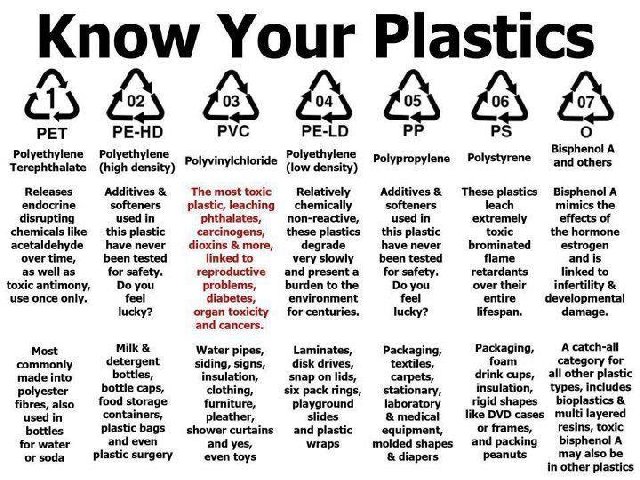If you look under most plastic containers and bottles, you would notice a triangular recycling number there. What the heck does the number means?
Well, actually the number label actually identifies the type of plastic polymer the containers are made of.
As indicated by the above picture, 1 indicates PET which is most commonly found in soft drink and water bottles, jam jars and salad dressing bottles. It is actually meant to be used for one time. Once the content is emptied, we should dispose it but over here, people tend to use them until they are broken!
Number 2 is a type of high density PE. Mostly found in milk, detergent and toiletries bottles, food storage containers, plastic bags, water pipes and five gallons buckets. Safe or not? Take your guess!
3 is for PVC. The most common plastic packaging materials mostly used for non food items. Electrical cable insulation, shower curtains and toys also use this material. See the risk there for children's toys? This is the most hazardous plastic materials which can lead to cancer and reproduction problems. BEWARE!!!
Low density PE takes up number 4. This soft and flexible plastic degrades slowly, therefore its hazard effect to us should be the lowest among all the plastic materials. Usually used as frozen food bags, squeezable bottles and lids and plastic wraps.
5 is for PP.Normally used as reusable microwaveable wares, disposable cups and plates, and also diapers. Hmmm..... should be safe.
PS is 6. Very safe is not inflammable. Run for life if it is under fire! Normally used as egg cartons, foam disposable drink cups, trays and plates.
Number 7 is all other plastics not categorized above. Can lead to reproductive problems. I wonder why some manufacturers use it for making beverage bottles and baby milk bottles.
Well, actually the number label actually identifies the type of plastic polymer the containers are made of.
As indicated by the above picture, 1 indicates PET which is most commonly found in soft drink and water bottles, jam jars and salad dressing bottles. It is actually meant to be used for one time. Once the content is emptied, we should dispose it but over here, people tend to use them until they are broken!
Number 2 is a type of high density PE. Mostly found in milk, detergent and toiletries bottles, food storage containers, plastic bags, water pipes and five gallons buckets. Safe or not? Take your guess!
3 is for PVC. The most common plastic packaging materials mostly used for non food items. Electrical cable insulation, shower curtains and toys also use this material. See the risk there for children's toys? This is the most hazardous plastic materials which can lead to cancer and reproduction problems. BEWARE!!!
Low density PE takes up number 4. This soft and flexible plastic degrades slowly, therefore its hazard effect to us should be the lowest among all the plastic materials. Usually used as frozen food bags, squeezable bottles and lids and plastic wraps.
5 is for PP.Normally used as reusable microwaveable wares, disposable cups and plates, and also diapers. Hmmm..... should be safe.
PS is 6. Very safe is not inflammable. Run for life if it is under fire! Normally used as egg cartons, foam disposable drink cups, trays and plates.
Number 7 is all other plastics not categorized above. Can lead to reproductive problems. I wonder why some manufacturers use it for making beverage bottles and baby milk bottles.

